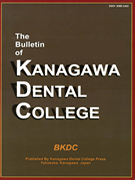- HOME
- > 一般の方
- > バックナンバー:The Bulletin of Kanagawa Dental College
- > 37巻2号
- > アブストラクト
アブストラクト(37巻2号:The Bulletin of Kanagawa Dental College)

English
| Title : | Application of Oral Appliances in Obstructive Sleep Apnea Syndrome |
|---|---|
| Subtitle : | CASE REPORT |
| Authors : | Jun Onozaki*1, Masahiko Takeda*2, Koichi Kuroki*3, Masafumi Inagaki*1, Yukiko Miyazawa*1, Jun Oba*1, Shigetoshi Yokoya*1, Masaki Kamata*4, Hiroo Oda*1, Toshio Morizane*5 |
| Authors(kana) : | |
| Organization : | *1Department of Comprehensive Dentistry, Division of Orthodontics, Yokohama Dental and Medical Clinic, Kanagawa Dental College, *2Department of Otorhinolaryngology, University of Kitasato School of Medicine, *3Kanagawa Dental College, *4Kamata Orthodontic Clinic, *5Department of Internal Medicine, Kanagawa Dental College |
| Journal : | The Bulletin of Kanagawa Dental College |
| Volume : | 37 |
| Number : | 2 |
| Page : | 117-121 |
| Year/Month : | 2009 / 9 |
| Article : | Report |
| Publisher : | Kanagawa Odontological Society |
| Abstract : | [Abstract] The use of oral appliances (OAs) has been increasing in the dental treatment of Obstructive Sleep Apnea Syndrome (OSAS). An OA positions the mandible forward during sleep to prevent upper airway obstruction, but there is insufficient data available on the morphology of the upper airway soft tissue during sleep with such a device in place. In order to obtain measurements of maxillofacial morphology and upper airway volume, with the purpose of designing an efficient OA, informed consent was obtained of a patient diagnosed with severe OSAS and a supine neck CT scan was performed. The supine neck CT scan was performed both during sleep and while awake, both with and without the OA. The results showed that the airway was not obstructed while awake, but that it was obstructed during sleep, and use of the OA did not in fact improve airway obstruction, but worsened it. Throughout the course of this essay, as far as the use of OAs in dentistry is concerned, it is very important to assess soft tissue morphology with OA usage. It is necessary to monitor the outcome over the long term, and caution must be exercised when using OAs. In patients with OSAS, it is important not only to improve sleep apnea, but also to assess and treat systemic disease. It is necessary to establish an interdisciplinary treatment system involving medicine and dentistry where ENT specialists collaborate with internists, orthodontists, and oral surgeons. |
| Practice : | Dentistry |
| Keywords : | Oral appliance, Obstructive sleep apnea syndrome, Upper airway |
